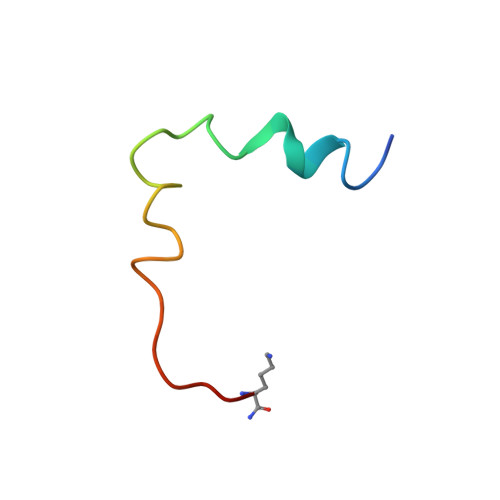Structural and Functional Characterization of Transmembrane Segment IX of the NHE1 Isoform of the Na+/H+ Exchanger.
Reddy, T., Ding, J., Li, X., Sykes, B.D., Rainey, J.K., Fliegel, L.(2008) J Biol Chem 283: 22018-22030
- PubMed: 18508767
- DOI: https://doi.org/10.1074/jbc.M803447200
- Primary Citation of Related Structures:
2K3C - PubMed Abstract:
The Na(+)/H(+) exchanger isoform 1 (NHE1) is an integral membrane protein that regulates intracellular pH by removing one intracellular H(+) in exchange for one extracellular Na(+). It has a large N-terminal membrane domain of 12 transmembrane segments and an intracellular C-terminal regulatory domain. We characterized the cysteine accessibility of amino acids of the putative transmembrane segment IX (residues 339-363). Each residue was mutated to cysteine in a functional cysteineless NHE1 protein. Of 25 amino acids mutated, 5 were inactive or nearly so after mutation to cysteine. Several of these showed aberrant targeting to the plasma membrane and reduced expression of the intact protein, whereas others were expressed and targeted correctly but had defective NHE1 function. Of the active mutants, Glu(346) and Ser(351) were inhibited >70% by positively charged [2-(trimethylammonium)-ethyl]methanethiosulfonate but not by anionic [2-sulfonatoethyl]methanethiosulfonate, suggesting that they are pore lining and make up part of the cation conduction pathway. Both mutants also had decreased affinity for Na(+) and decreased activation by intracellular protons. The structure of a peptide representing amino acids 338-365 was determined by using high resolution NMR in dodecylphosphocholine micelles. The structure contained two helical regions (amino acids Met(340)-Ser(344) and Ile(353)-Ser(359)) kinked with a large bend angle around a pivot point at amino acid Ser(351). The results suggest that transmembrane IX is critical with pore-lining residues and a kink at the functionally important residue Ser(351).
Organizational Affiliation:
Department of Biochemistry and Molecular Biology, Dalhousie University, Halifax, Nova Scotia B3H 1X5, Canada.














